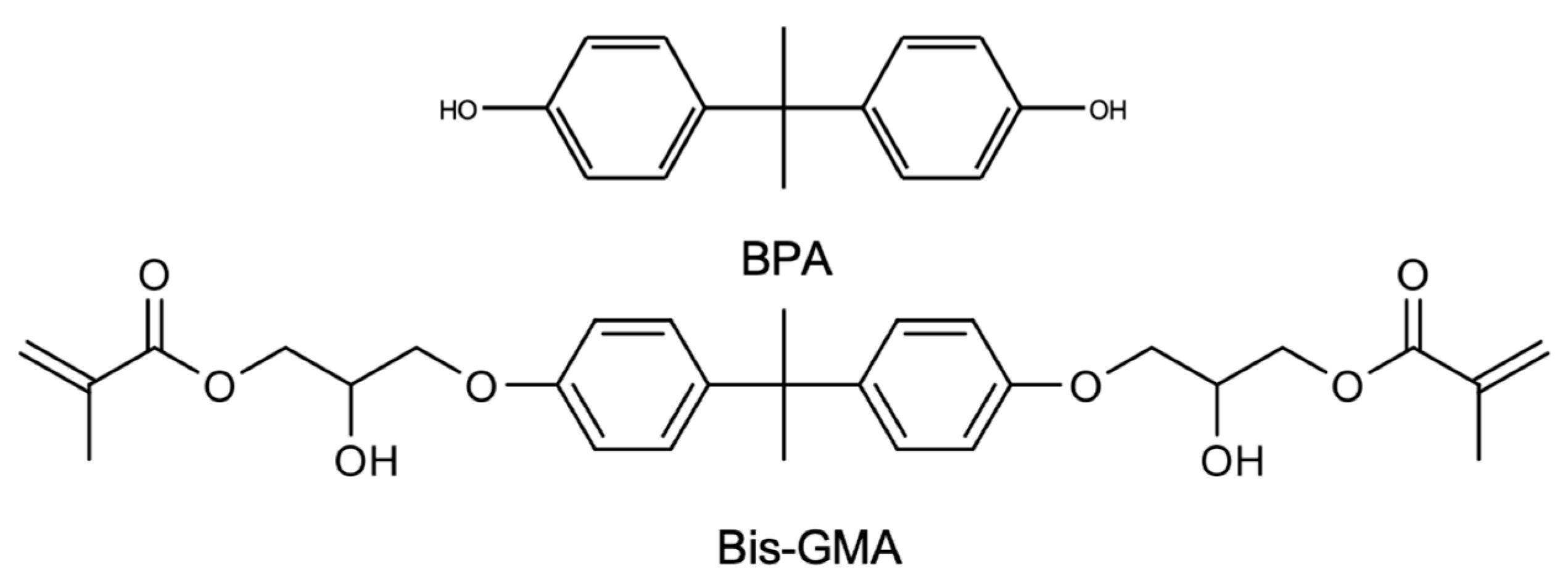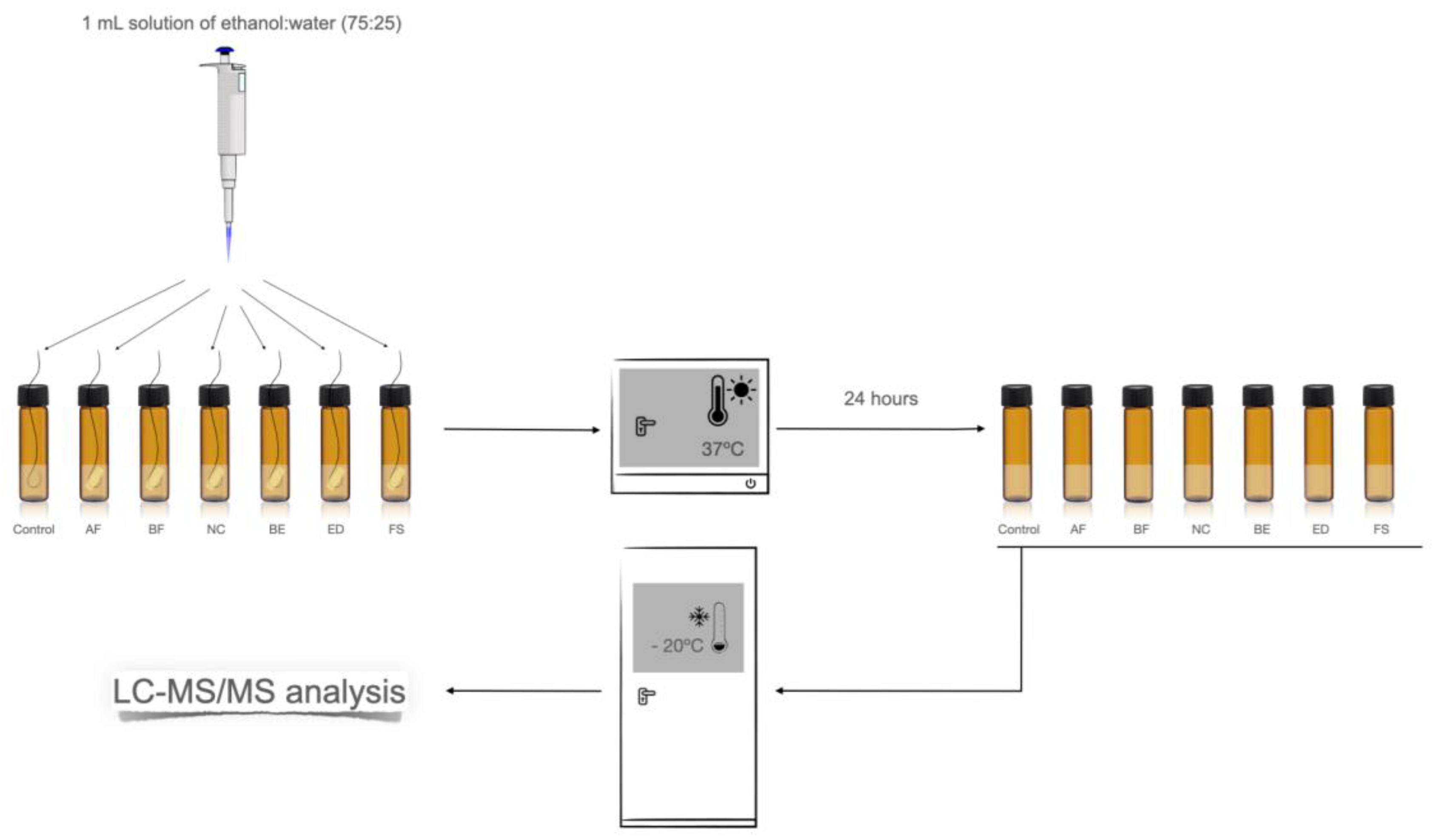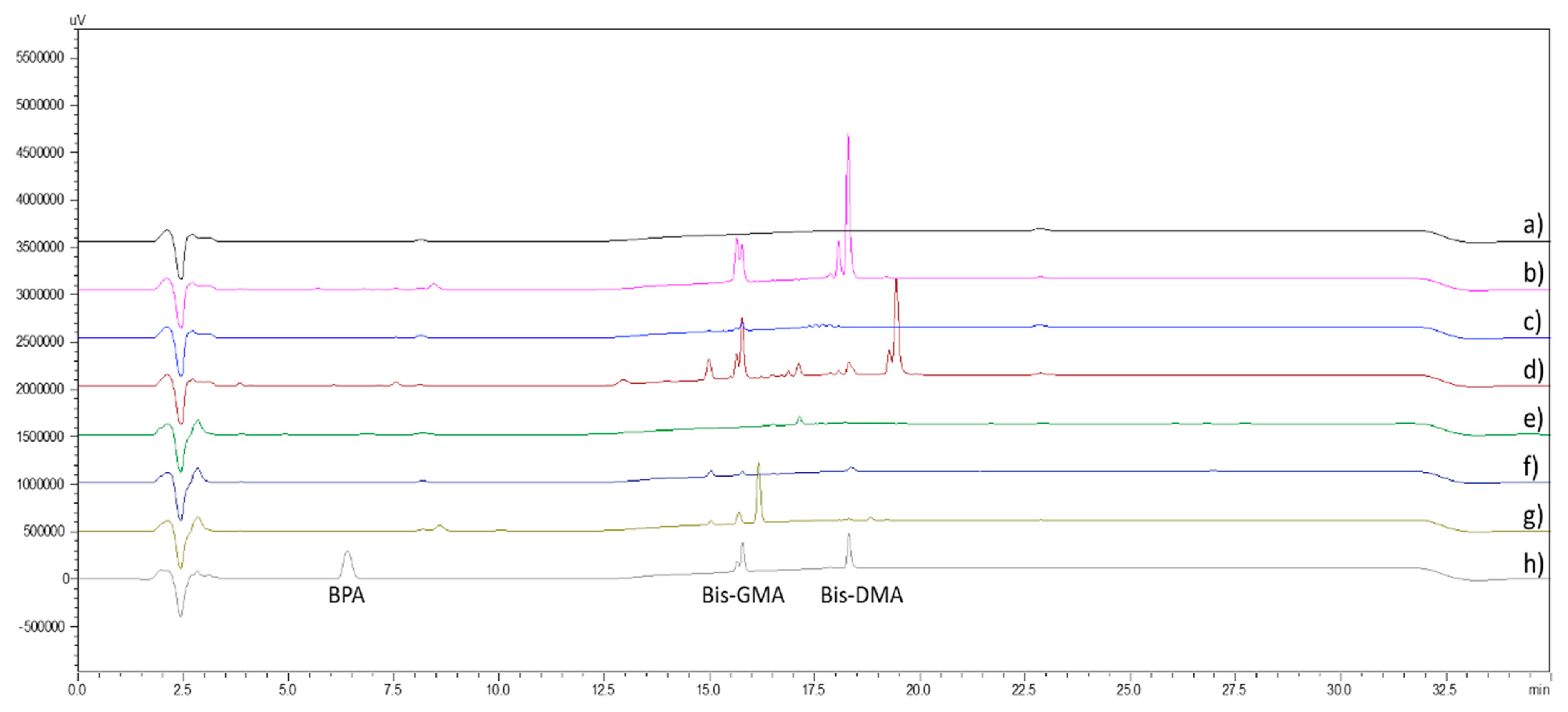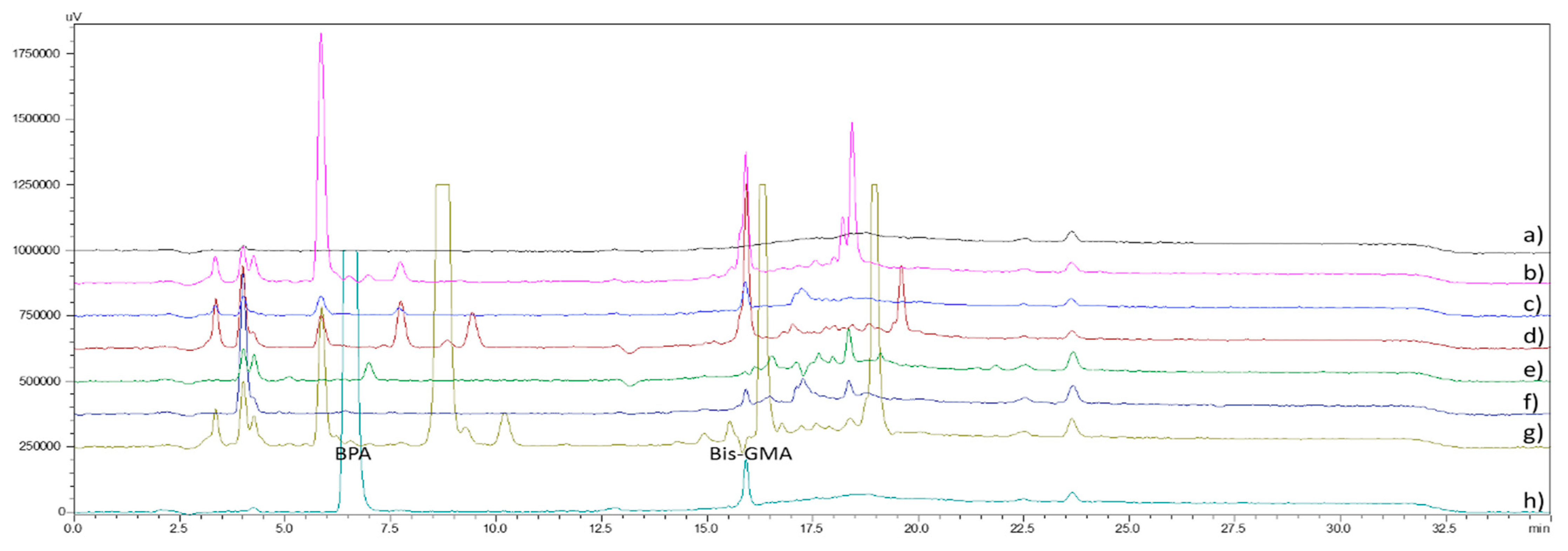Evaluation of BPA and Bis-GMA Release from Recent Dental Composite Materials by LC-MS/MS
Abstract
:1. Introduction
2. Materials and Methods
2.1. Resin Composites Used
2.2. Chemicals and Reagents Used
2.3. Preparation of Resin Composite Samples and Eluates
2.4. High-Performance Liquid Chromatography with UV and Fluorescence Detection (HPLC-UV/FD) Analysis
2.5. LC-MS/MS Analysis
3. Results
3.1. HPLC-UV/FD Analysis
3.2. BPA and Bis-GMA Leaching Experiment
4. Discussion
5. Conclusions
Supplementary Materials
Author Contributions
Funding
Institutional Review Board Statement
Informed Consent Statement
Data Availability Statement
Acknowledgments
Conflicts of Interest
References
- Araujo, E.; Perdigão, J. Anterior Veneer Restorations-An evidence-based minimal-intervention perspective. J. Adhes. Dent. 2021, 23, 91–110. [Google Scholar] [CrossRef]
- Hu, C.-J.; Yu, H.-C.; Chang, Y.-C. Investigation of the impact of dental care via composite resin restoration among children with attention deficit hyperactivity disorder: A registry-based nested case–control study. Healthcare 2021, 9, 803. [Google Scholar] [CrossRef]
- Adriana, M.V.; Camila, C.S.; Vinícius, M.C.; Hans, H.A.; Rodrigo, A.C.; Allyson, M.N.; Fernando, M.S.L. Direct guided restorations from planning to definitive restoration: A clinical report. J. Prosthet. Dent. 2023, 129, 2–6. [Google Scholar] [CrossRef]
- Comba, A.; Vergano, E.A.; Baldi, A.; Alovisi, M.; Pasqualini, D.; Castroflorio, T.; Stura, I.; Migliaretti, G.; Berutti, E.; Scotti, N. 5-year retrospective evaluation of direct composite restorations in orthodontically treated patients. J. Dent. 2021, 104, 103510. [Google Scholar] [CrossRef]
- Rocha, L.; Garcez, J.; Tiritan, M.E.; da Silva, L.F.M.; Pinho, T. Maxillary lateral incisor agenesis and microdontia: Minimally invasive symmetric and asymmetric esthetic rehabilitation. Rev. Port. Estomatol. Med. Dentária Cir. Maxilofac. 2022, 62, 41–51. [Google Scholar] [CrossRef]
- Krishnakumar, S.; Senthilvelan, T. Polymer composites in dentistry and orthopedic applications—A review. Mater. Today Proc. 2021, 46, 9707–9713. [Google Scholar] [CrossRef]
- Janda, R. Dental Resins-Material Science & Technology: Basic Level; Tredition GmbH: Hamburg, Germany, 2021; Volume 1, ISBN 9783347287846. [Google Scholar]
- Ferracane, J.L. Resin composite-State of the art. Dent. Mater. 2011, 27, 29–38. [Google Scholar] [CrossRef]
- Aminoroaya, A.; Neisiany, R.E.; Khorasani, S.N.; Panahi, P.; Das, O.; Madry, H.; Cucchiarini, M.; Ramakrishna, S. A review of dental composites: Challenges, chemistry aspects, filler influences, and future insights. Compos. Part B Eng. 2021, 216, 108852. [Google Scholar] [CrossRef]
- Al-Tannak, N.F.; Alzoubi, F.; Kareem, F.M.; Novotny, L. Determination of endocrine disruptor bisphenol-A leakage from different matrices of dental resin-based composite materials. Curr. Pharm. Anal. 2022, 18, 305–315. [Google Scholar] [CrossRef]
- Janani, K.; Teja, K.V.; Sandhya, R.; Alam, M.K.; Al-Qaisi, R.K.; Shrivastava, D.; Alnusayri, M.O.; Alkhalaf, Z.A.; Sghaireen, M.G.; Srivastava, K.C. monomer elution from three resin composites at two different time interval using high performance liquid chromatography—An in-vitro study. Polymers 2021, 13, 4395. [Google Scholar] [CrossRef]
- Arenholt-Bindslev, D.; Breinholt, V.; Preiss, A.; Schmalz, G. Time-related bisphenol-A content and estrogenic activity in saliva samples collected in relation to placement of fissure sealants. Clin. Oral Investig. 1999, 3, 120–125. [Google Scholar] [CrossRef]
- Hassan, R.; Aslam Khan, M.U.; Abdullah, A.M.; Abd Razak, S.I. A Review on current trends of polymers in orthodontics: BPA-free and smart materials. Polymers 2021, 13, 1409. [Google Scholar] [CrossRef]
- Lopes-Rocha, L.; Ribeiro-Gonçalves, L.; Henriques, B.; Özcan, M.; Tiritan, M.E.; Souza, J.C.M. An integrative review on the toxicity of Bisphenol A (BPA) released from resin composites used in dentistry. J. Biomed. Mater. Res. B Appl. Biomater. 2021, 109, 1942–1952. [Google Scholar] [CrossRef]
- European Food Safety Authority. Opinion of the Scientific Panel on food additives, flavourings, processing aids and materials in contact with food (AFC) related to 2,2-bis(4-hydroxyphenyl)propane. Eur. Food Saf. Auth. 2007, 1–75. Available online: https://www.efsa.europa.eu/en/efsajournal/pub/428 (accessed on 2 February 2020).
- Bisphenol, A.; ECHA. All News—ECHA (europa.eu). Available online: https://echa.europa.eu/-/group-assessment-of-bisphenols-identifies-need-for-restriction (accessed on 12 August 2023).
- Fenichel, P.; Chevalier, N.; Brucker-Davis, F. Bisphenol A: An endocrine and metabolic disruptor. Ann. Endocrinol. 2013, 74, 211–220. [Google Scholar] [CrossRef]
- Legeay, S.; Faure, S. Is bisphenol A an environmental obesogen? Fundam. Clin. Pharmacol. 2017, 31, 594–609. [Google Scholar] [CrossRef]
- Hessel, E.V.S.; Ezendam, J.; van Broekhuizen, F.A.; Hakkert, B.; DeWitt, J.; Granum, B.; Guzylack, L.; Lawrence, B.P.; Penninks, A.; Rooneyet, A.A.; et al. Assessment of recent developmental immunotoxicity studies with bisphenol A in the context of the 2015 EFSA t-TDI. Reprod. Toxicol. 2016, 65, 448–456. [Google Scholar] [CrossRef]
- Patisaul, H.B. Achieving CLARITY on bisphenol A, brain and behaviour. J. Neuroendocrinol. 2020, 32, e12730. [Google Scholar] [CrossRef]
- Ramírez, V.; Gálvez-Ontiveros, Y.; González-Domenech, P.J.; Baca, M.Á.; Rodrigo, L.; Rivas, A. Role of endocrine disrupting chemicals in children’s neurodevelopment. Environ. Res. 2022, 203, 111890. [Google Scholar] [CrossRef]
- Minatoya, M.; Kishi, R. A review of recent studies on bisphenol A and phthalate exposures and child neurodevelopment. Int. J. Environ. Res. Public Health 2021, 18, 3585. [Google Scholar] [CrossRef]
- Putzeys, E.; Nys SDe Cokic, S.M.; Duca, R.C.; Vanoirbeek, J.; Godderis, L.; Van Meerbeek, B.; Van Landuyt, K.L. Long-term elution of monomers from resin-based dental composites. Dent. Mater 2019, 35, 477–485. [Google Scholar] [CrossRef]
- Pulgar, R.; Olea-Serrano, M.F.; Novillo-Fertrell, A.; Rivas, A.; Pazos, P.; Pedraza, V.; Navajas, J.M.; Olea, N. Determination of bisphenol A and related aromatic compounds released from Bis-GMA-based composites and sealants by high performance liquid chromatography. Environ. Health Perspect. 2000, 108, 21–27. [Google Scholar] [CrossRef]
- Papakonstantinou, A.E.; Eliades, T.; Cellesi, F.; Watts, D.C.; Silikas, N. Evaluation of UDMA’s potential as a substitute for Bis-GMA in orthodontic adhesives. Dent. Mater. 2013, 29, 898–905. [Google Scholar] [CrossRef] [PubMed]
- Floyd, C.J.E.; Dickens, S.H. Network structure of Bis-GMA- and UDMA-based resin systems. Dent. Mater. 2006, 22, 1143–1149. [Google Scholar] [CrossRef]
- Kalra, S.; Singh, A.; Gupta, M.; Chadha, V. Ormocer: An aesthetic direct restorative material; An in vitro study comparing the marginal sealing ability of organically modified ceramics and a hybrid composite using an ormocer-based bonding agent and a conventional fifth-generation bonding agent. Contemp. Clin. Dent. 2012, 3, 48. [Google Scholar] [CrossRef]
- Gregor, L.; Krejci, I.; Di Bella, E.; Feilzer, A.J.; Ardu, S. Silorane, ormocer, methacrylate and compomer long-term staining susceptibility using ΔE and ΔE 00 colour-difference formulas. Odontology 2016, 104, 305–309. [Google Scholar] [CrossRef]
- Manhart, J.; Kunzelmann, K.H.; Chen, H.Y.; Hickel, R. Mechanical properties of new composite restorative materials. J. Biomed. Mater. Res. 2000, 53, 353–361. [Google Scholar] [CrossRef]
- Yap, A.U.; Wong, N.Y.; Siow, K.S. Composite cure and shrinkage associated with high intensity curing light. Oper. Dent. 2003, 28, 357–364. [Google Scholar]
- Silva, T.M.D.; Sales, A.L.L.S.; Pucci, C.R.; Borges, A.B.; Torres, C.R.G. The combined effect of food-simulating solutions, brushing and staining on color stability of composite resins. Acta Biomater. Odontol. Scand. 2017, 3, 1–7. [Google Scholar] [CrossRef] [PubMed]
- Karaarslan, E.S.; Altintas, S.; Bulbul, M.; Cebe, M.A.; Usumez, A. High performance liquid chromatography analysis of monomers from one composite resin cured with different polymerisation methods. Mater. Res. Innov. 2011, 15, 124–129. [Google Scholar] [CrossRef]
- Durner, J.; Spahl, W.; Zaspel, J.; Schweikl, H.; Hickel, R.; Reichl, F.-X. Eluted substances from unpolymerized and polymerized dental restorative materials and their Nernst partition coefficient. Dent. Mater. 2010, 26, 91–99. [Google Scholar] [CrossRef] [PubMed]
- Yap, A.U.; Han, V.T.; Soh, M.S.; Siow, K.S. Elution of leachable components from composites after LED and halogen light irradiation. Oper. Dent. 2004, 29, 448–453. [Google Scholar] [PubMed]
- Polydorou, O.; Huberty, C.; Wolkewitz, M.; Bolek, R.; Hellwig, E.; Kümmerer, K. The effect of storage medium on the elution of monomers from composite materials. J. Biomed. Mater. Res. Part B Appl. Biomater. 2012, 100B, 68–74. [Google Scholar] [CrossRef] [PubMed]
- Ferracane, J.L. Elution of leachable components from composites. J. Oral Rehabil. 1994, 21, 441–452. [Google Scholar] [CrossRef]
- Tabatabaee, M.H.; Mahdavi, H.; Zandi, S.; Kharrazi, M.J. HPLC analysis of eluted monomers from two composite resins cured with LED and halogen curing lights. J. Biomed. Mater. Res. Part B Appl. Biomater. 2009, 88, 191–196. [Google Scholar] [CrossRef] [PubMed]
- Manojlovic, D.; Radisic, M.; Vasiljevic, T.; Zivkovic, S.; Lausevic, M.; Miletic, V. Monomer elution from nanohybrid and ormocer-based composites cured with different light sources. Dent. Mater. 2011, 27, 371–378. [Google Scholar] [CrossRef]
- Durner, J.; Stojanovic, M.; Urcan, E.; Hickel, R.; Reichl, F.X. Influence of silver nano-particles on monomer elution from light-cured composites. Dent. Mater. 2011, 27, 631–636. [Google Scholar] [CrossRef]
- Šimková, M.; Tichý, A.; Dušková, M.; Bradna, P. Dental Composites–a Low-Dose Source of Bisphenol A? Physiol. Res. 2020, 69, S295–S304. [Google Scholar] [CrossRef]
- Lofroth, M.; Ghasemimehr, M.; Falk, A.; Steyern Vult von, P. Bisphenol A in dental materials—existence, leakage and biological effects. Heliyon 2019, 5, e01711. [Google Scholar] [CrossRef]
- Polydorou, O.; Trittler, R.; Hellwig, E.; Kummerer, K. Elution of monomers from two conventional dental composite materials. Dent. Mater. 2007, 23, 1535–1541. [Google Scholar] [CrossRef]
- Becher, R.; Wellendorf, H.; Sakhi, A.K.; Samuelsen, J.T.; Thomsen, C.; Bølling, A.K.; Kopperud, H.M. Presence and leaching of bisphenol A(BPA) from dental materials. Acta Biomater. Odontol. Scand. 2018, 4, 56–62. [Google Scholar] [CrossRef]
- Sideridou, I.D.; Karabela, M.M.; Vouvoudi, E.C. Physical properties of current dental nanohybrid and nanofill light-cured resin composites. Dent. Mater. 2011, 27, 598–607. [Google Scholar] [CrossRef]
- Sideridou, I.D.; Achilias, D.S. Elution study of unreacted Bis-GMA, TEGDMA, UDMA, and Bis-EMA from light-cured dental resins and resin composites using HPLC. J. Biomed. Mater. Res. B Appl. Biomater. 2005, 74, 617–626. [Google Scholar] [CrossRef] [PubMed]
- Bowen, R.L. Use of epoxy resins in restorative materials. J. Dent. Res. 1956, 35, 360–369. [Google Scholar] [CrossRef] [PubMed]
- He, J.; Söderling, E.; Vallittu, P.K.; Lassila, L.V.J. Preparation and Evaluation of Dental Resin with Antibacterial and Radio-Opaque Functions. Int. J. Mol. Sci. 2013, 14, 5445–5460. [Google Scholar] [CrossRef]
- MacAulay, M.; Tam, L.E.; Santerre, J.P.; Finer, Y. In vivo biodegradation of bisGMA and Urethane-Modified bisGMA-based resin composite materials. JDR Clin. Transl. Res. 2017, 2, 397–405. [Google Scholar] [CrossRef]
- Kingman, A.; Hyman, J.; Masten, S.A.; Jayaram, B.; Smith, C.; Eichmiller, F.; Arnold Michael, C.; Wong Paul, A.; Schaeffer James, M.; Solanki, S.; et al. Bisphenol A and other compounds in human saliva and urine associated with the placement of composite restorations. J. Am. Dent. Assoc. 2012, 143, 1292–1302. [Google Scholar] [CrossRef]
- Finer, Y.; Santerre, J.P. Biodegradation of a dental composite by esterases: Dependence on enzyme concentration and specificity. J. Biomater. Sci. Polym. Ed. 2003, 14, 837–849. [Google Scholar] [CrossRef] [PubMed]
- Urcan, E.; Scherthan, H.; Styllou, M.; Haertel, U.; Hickel, R.; Reichl, F.-X. Induction of DNA double-strand breaks in primary gingival fibroblasts by exposure to dental resin composites. Biomaterials 2010, 31, 2010–2014. [Google Scholar] [CrossRef]
- Putzeys, E.; Cokic, S.M.; Chong, H.; Smet, M.; Vanoirbeek, J.; Godderis, L.; Van Meerbeek, B.; Van Landuyt, K.L.; Duca, R.C. Simultaneous analysis of bisphenol A based compounds and other monomers leaching from resin-based dental materials by UHPLC-MS/MS. J. Sep. Sci. 2017, 40, 1063–1075. [Google Scholar] [CrossRef]
- Lewis, J.B.; Rueggeberg, F.A.; Lapp, C.A.; Ergle, J.W.; Schuster, G.S. Identification and characterization of estrogen-like components in commercial resin-based dental restorative materials. Clin. Oral Investig. 1999, 3, 107–113. [Google Scholar] [CrossRef]
- Fleisch, A.F.; Sheffield, P.E.; Chinn, C.; Edelstein, B.L.; Landrigan, P.J. Bisphenol A and Related Compounds in Dental Materials. Pediatrics 2010, 126, 760–768. [Google Scholar] [CrossRef] [PubMed]
- De Nys, S.; Duca, R.C.; Vervliet, P.; Covaci, A.; Boonen, I.; Elskens, M.; Vanoirbeek, J.; Godderis, L.; Van Meerbeek, B.; Van Landuyt, K.L. Bisphenol A as degradation product of monomers used in resin-based dental materials. Dent. Mater. 2021, 37, 1020–1029. [Google Scholar] [CrossRef]
- Bonefeld-Jørgensen, E.C.; Long, M.; Hofmeister, M.V.; Vinggaard, A.M. Endocrine-Disrupting Potential of Bisphenol A, Bisphenol A Dimethacrylate, 4-n-Nonylphenol, and 4-n-Octylphenol in vitro: New data and a brief review. Environ. Health Perspect. 2007, 115, 69–76. [Google Scholar] [CrossRef]
- Tarumi, H.; Imazato, S.; Narimatsu, M.; Matsuo, M.; Ebisu, S. Estrogenicity of fissure sealants and adhesive resins determined by reporter gene assay. J. Dent. Res. 2000, 79, 1838–1843. [Google Scholar] [CrossRef] [PubMed]
- Bakopoulou, A.; Papadopoulos, T.; Garefis, P. Molecular toxicology of substances released from resin–based dental restorative materials. Int. J. Mol. Sci. 2009, 10, 3861–3899. [Google Scholar] [CrossRef]
- Al-Hiyasat, A.S.; Darmani, H. In vivo effects of BISGMA—A component of dental composite—On male mouse reproduction and fertility. J. Biomed. Mater. Res. Part A 2006, 78A, 66–72. [Google Scholar] [CrossRef] [PubMed]
- Mariotti, A.; Söderholm, K.-J.; Johnson, S. The in vivo effects of bisGMA on murine uterine weight, nucleic acids and collagen. Eur. J. Oral Sci. 1998, 106, 1022–1027. [Google Scholar] [CrossRef]
- De Nys, S.; Putzeys, E.; Vervliet, P.; Covaci, A.; Boonen, I.; Elskens, M.; Vanoirbeek, J.; Godderis, L.; Van Meerbeek, B.; Van Landuyt, K.L.; et al. A novel high sensitivity UPLC-MS/MS method for the evaluation of bisphenol A leaching from dental materials. Sci. Rep. 2018, 8, 6981. [Google Scholar] [CrossRef]
- Pongprueksa, P.; De Munck, J.; Duca, R.C.; Poels, K.; Covaci, A.; Hoet, P.; Godderis, L.; Van Meerbeek, B.; Van Landuyt, K.L. Monomer elution in relation to degree of conversion for different types of composite. J. Dent. 2015, 43, 1448–1455. [Google Scholar] [CrossRef]
- Leprince, J.G.; Palin, W.M.; Hadis, M.A.; Devaux, J.; Leloup, G. Progress in dimethacrylate-based dental composite technology and curing efficiency. Dent. Mater. 2013, 29, 139–156. [Google Scholar] [CrossRef]
- Purushothaman, D.; Kailasam, V.; Chitharanjan, A.B. Bisphenol A release from orthodontic adhesives and its correlation with the degree of conversion. Am. J. Orthod. Dentofac. Orthop. 2015, 147, 29–36. [Google Scholar] [CrossRef] [PubMed]
- Rueggeberg, F.A.; Craig, R.G. Correlation of parameters used to estimate monomer conversion in a light-cured composite. J Dent. Res. 1988, 67, 932–937. [Google Scholar] [CrossRef] [PubMed]
- Cokic, S.M.; Duca, R.C.; De Munck, J.; Hoet, P.; Van Meerbeek, B.; Smet, M.; Godderis, L.; Van Landuyt, K.L. Saturation reduces in-vitro leakage of monomers from composites. Dent. Mater. 2018, 34, 579–586. [Google Scholar] [CrossRef] [PubMed]
- Bezgin, T.; Cimen, C.; Ozalp, N. Evaluation of residual monomers eluted from pediatric dental restorative materials. Biomed. Res. Int. 2021, 2021, 6316171. [Google Scholar] [CrossRef] [PubMed]
- Ozgünaltay, G.; Yazici, A.R.; Görücü, J. Effect of finishing and polishing procedures on the surface roughness of new tooth-coloured restoratives. J. Oral Rehabil. 2003, 30, 218–224. [Google Scholar] [CrossRef]
- Tichy, A.; Simkova, M.; Vrbova, R.; Roubickova, A.; Duskova, M.; Bradna, P. Bisphenol A release from dental composites and resin-modified glass ionomers under two polymerization conditions. Polymers 2022, 14, 46. [Google Scholar] [CrossRef]
- Hope, E.; Reed, D.R.; Moilanen, L.H. Potential confounders of bisphenol-a analysis in dental materials. Dent. Mater. 2016, 32, 961–967. [Google Scholar] [CrossRef]
- Noda, M.; Komatsu, H.; Sano, H. HPLC analysis of dental resin composites components. J. Biomed. Mater. Res. 1999, 47, 374–378. [Google Scholar] [CrossRef]
- Van Landuyt, K.L.; Nawrot, T.; Geebelen, B.; De Munck, J.; Snauwaert, J.; Yoshihara, K.; Scheers, H.; Godderis, L.; Hoet, P.; Van Meerbeek, B. How much do resin-based dental materials release? A meta-analytical approach. Dent. Mater. 2011, 27, 723–747. [Google Scholar] [CrossRef]
- Mourouzis, P.; Andreasidou, E.; Samanidou, V.; Tolidis, K. Short-term and long-term release of monomers from newly developed resin-modified ceramics and composite resin CAD-CAM blocks. J. Prosthet. Dent. 2020, 123, 339–348. [Google Scholar] [CrossRef]
- Polydorou, O.; König, A.; Hellwig, E.; Kümmerer, K. Long-term release of monomers from modern dental-composite materials. Eur. J. Oral Sci. 2009, 117, 68–75. [Google Scholar] [CrossRef] [PubMed]
- Deviot, M.; Lachaise, I.; Högg, C.; Durner, J.; Reichl, F.X.; Attal, J.P.; Dursun, E. Bisphenol A release from an orthodontic resin composite: A GC/MS and LC/MS study. Dent. Mater. 2018, 34, 341–354. [Google Scholar] [CrossRef] [PubMed]






| Resin | Brand | Manufacturer | Composition | Filler by Weight (%) | Filler Dimension (μm) | Water Sorption (μg/mm3) | Water Solubility (μg/mm3) |
|---|---|---|---|---|---|---|---|
| AF † | Admira® Fusion | VOCO, Cuxhaven, Germany | ORMOCER® resin, SiO2 Ba-Al-B-Si-glass fillers | 84 | 2.5 to 3.0 | 13.4 | ≤0.1 |
| BF† | Enamel Plus HRI BIO Function | Micerium SpA, Avegno, Italy | UDMA, TCDDMA, no co-monomers, and no Bis-GMA glass filler, high dispersion silicon dioxide, fluorine | 74 | 0.2 to 3.0 | 15.27 | 0.31 |
| NC | Experimental resin | Coltène-Whaledent, Altäsatten, Switzerland | n.a. | n.a. | n.a. | n.a. | n.a. |
| BE | BRILLIANT EverGlowTM | Coltène-Whaledent, Altäsatten, Switzerland | Bis-GMA*, TEGDMA, Bis-EMA*, ZnO, Amorphous silica fillers | 79 | 0.4 to 0.7 | 15.1 | <0.1 |
| ED | IPS Empress Direct | Ivoclar Vivadent, Schaan Liechtenstein | Bis-GMA*, UDMA, TCDD, Ba-Al-Si-glass, YbF3, SiO2/ZrO2, MO, Nanomodifier | 78 | 0.1 to 0.3 | 19.6 | <0.1 |
| FS | FiltekTM Supreme XTE | 3M ESPE, MN, USA | Bis-GMA*, UDMA, TEGDMA, Bis-EMA*, ZrO2/SiO2 cluster SiO2 nano-scale fillers | 72.5 | 0.6 to 20 | n.a. | n.a. |
| Compound | MRM Transition (m/z) | Cone Voltage (V) | Collision Energy (eV) |
|---|---|---|---|
| BPA | 227 > 133 222 > 211 | 35 40 | 25 30 |
| Bis-GMA | 513 > 277 513 > 427 513 > 496 | 30 30 30 | 11 11 11 |
| LOD (ng/mL) | LOQ (ng/mL) | Range (ng/mL) | Linear Regression | r2 | Quality Control (ng/mL) | Accuracy (%) | |
|---|---|---|---|---|---|---|---|
| BPA | 0.06 | 0.2 | 0.2–6.4 | y = 1804.1x − 314.55 | 0.9914 | 1.6 | [92.52–105.9] |
| Bis-GMA | 0.03 | 0.1 | 0.4–25 | y = 2539.2x − 852.62 | 0.9986 | 6.4 | [82.60–122.7] |
| Concentration Released by Day (ng/mL) (n = 5) | ||||||||||
|---|---|---|---|---|---|---|---|---|---|---|
| Sample | 1 | 2 | 3 | 4 | 5 | 6 | 7 | Total Released (ng/mL) | Total Released (ng/mm3) | |
| AF | BPA | ND | ND | ND | ND | ND | - | - | ND | ND |
| Bis-GMA | ND | ND | ND | ND | ND | - | - | ND | ND | |
| BF | BPA | ND | ND | ND | ND | ND | - | - | ND | ND |
| Bis-GMA | ND | ND | ND | ND | ND | - | - | ND | ND | |
| NC | BPA | ND | ND | ND | ND | ND | - | - | ND | ND |
| Bis-GMA | 0.53 ± 0.05 | 0.41 ± 0.05 | <LOQ | <LOQ | <LOQ | - | - | 0.94 | 0.02 | |
| BE | BPA | ND | ND | ND | ND | ND | ND | ND | ND | ND |
| Bis-GMA | 15.46 ± 3.94 | 4.96 ± 1.04 | 3.22 ± 0.62 | 1.88 ± 0.19 | 6.51 ± 0.53 | 4.00 ± 0.43 | 4.71 ± 0.39 | 40.75 | 0.72 | |
| FS | BPA | ND | ND | ND | ND | ND | ND | ND | ND | ND |
| Bis-GMA | 3.60 ± 0.983 | 1.01 ± 0.037 | 0.74 ± 0.029 | 0.53 ± 0.035 | 0.95 ± 0.061 | 0.71 ± 0.042 | 0.76 ± 0.057 | 8.30 | 0.15 | |
| ED | BPA | ND | ND | ND | ND | ND | ND | ND | ND | ND |
| Bis-GMA | 33.46 ± 3.97 | 7.09 ± 1.21 | 4.35 ± 0.66 | 2.38 ± 0.29 | 8.95 ± 2.55 | 5.22 ± 0.64 | 5.98 ± 0.60 | 67.43 | 1.19 | |
Disclaimer/Publisher’s Note: The statements, opinions and data contained in all publications are solely those of the individual author(s) and contributor(s) and not of MDPI and/or the editor(s). MDPI and/or the editor(s) disclaim responsibility for any injury to people or property resulting from any ideas, methods, instructions or products referred to in the content. |
© 2023 by the authors. Licensee MDPI, Basel, Switzerland. This article is an open access article distributed under the terms and conditions of the Creative Commons Attribution (CC BY) license (https://creativecommons.org/licenses/by/4.0/).
Share and Cite
Lopes-Rocha, L.; Gonçalves, V.M.F.; Cunha, S.C.; Fernandes, J.O.; Pinho, T.; Tiritan, M.E. Evaluation of BPA and Bis-GMA Release from Recent Dental Composite Materials by LC-MS/MS. Separations 2023, 10, 455. https://doi.org/10.3390/separations10080455
Lopes-Rocha L, Gonçalves VMF, Cunha SC, Fernandes JO, Pinho T, Tiritan ME. Evaluation of BPA and Bis-GMA Release from Recent Dental Composite Materials by LC-MS/MS. Separations. 2023; 10(8):455. https://doi.org/10.3390/separations10080455
Chicago/Turabian StyleLopes-Rocha, Lígia, Virgínia M. F. Gonçalves, Sara C. Cunha, José O. Fernandes, Teresa Pinho, and Maria Elizabeth Tiritan. 2023. "Evaluation of BPA and Bis-GMA Release from Recent Dental Composite Materials by LC-MS/MS" Separations 10, no. 8: 455. https://doi.org/10.3390/separations10080455
APA StyleLopes-Rocha, L., Gonçalves, V. M. F., Cunha, S. C., Fernandes, J. O., Pinho, T., & Tiritan, M. E. (2023). Evaluation of BPA and Bis-GMA Release from Recent Dental Composite Materials by LC-MS/MS. Separations, 10(8), 455. https://doi.org/10.3390/separations10080455










